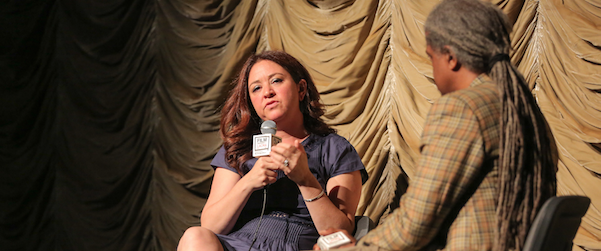Documentarian Liz Garbus Reveals the Ferocity and the Fragility of Nina Simone
“Black lives matter!” someone yelled when Film Independent Curator Elvis Mitchell took the stage to introduce the latest documentary by Liz Garbus, What Happened Miss Simone? at Film Independent at LACMA this past Thursday. “Thank you for saying that,” Mitchell responded, “because there’s no better time so see this movie than now.”
Indeed, 12 years after her death, the power of Nina Simone’s music and the fearlessness of her civil rights message—a black woman “speaking the truth to power” as Garbus puts it—resonates as strongly as ever, given the epidemic of police violence against black men and women nationwide, as well as the recent church massacre in Charleston.
The film, which premiered on Netflix this past Friday, is the kind of documentary that will often be called “unflinching.” That’s because Garbus steers her story directly at the faces of the demons that infiltrate Simone’s personal life and her career as an artist. There is interview footage of her husband/manager Arthur, speaking openly about beating her. There are Nina’s hand-written diaries, which reveal her deep depression and suicidal thoughts. (Later in life, she would be diagnosed as bi-polar.) There are interviews with her daughter Lisa about the physical and emotional abuse she suffered at the hands of her mother. And there is footage of Simone’s own aggressive outbursts on stage. At the start of one concert, she stops playing piano and singing mid-note to yell at someone in the audience, “Sit DOWN!” She waits, holding the audience hostage, and yells again. “Sit DOWN!”
The film opens with a mesmerizing moment during another performance. Nina, a possessed look in her eye, glares toward the audience. She waits, frozen. After a long period of uncomfortable silence, she sits down at the piano and declares, “This will be my last jazz performance. I’m going to graduate to another plane. You don’t know what I mean.”
“When I first saw that clip,” Garbus said, “I was like, ‘This is where the movie starts.’ It was clear to me that that was the question. What brought her to this moment?”
“The way she’s playing, you can hear these conflicts in her life and music,” said Mitchell. “Every single song she played, no matter how celebratory or how dark, those conflicts [were apparent], there’s drama in the way she lived as an artist.”
“She was as fragile as she was strong,” Garbus said.

Simone’s rags-to-riches-to-rags life story begins with her training as a classical pianist as a little girl in the Jim Crow-era south, moves through her rise to the “high priestess of soul” and follows her political awakening and radicalization in the ‘60s. Simone wrote one of the defining songs of the era, Mississippi Goddamn—a shocking statement for a black woman at the time—and embraced the by-any-means-necessary ideology of the Black Panthers, calling for violence as a means of self-defense. “I am not non-violent,” she once declared to MLK. Despite her husband’s concerns that her militant stance would hurt her career—and it did—Simone was unwavering. “An artist’s duty is to represent the times,” she said.
“We’ve seen a lot of films about those who were killed and gave their lives in the civil rights movement, but what about those who survived and gave everything to the civil rights movement? As [Malcolm X’s daughter] Ambassador Shabbaz says, ‘the commercial side of her career, her family, sanity, she gave it all. She left it all on the mat and the mat got thrown out.’”
Mitchell pointed out that Garbus’s filmography reveals her attraction to people “whose gifts inform them and isolate them.” In 2011 she made Bobby Fischer Against the World, and the following year, Love Marilyn, about Marilyn Monroe. “To quote Ambassador Shabazz, because nobody can say things better than she can, ‘It’s about what happens when your soul can’t do what it needs to do. The conversations around mental health, about the rage, and the civil rights movement… You can never separate them. And that was one of the challenges in structuring the film, how do you keep all of these forces that are acting on Nina present?”
The film takes its title from an essay that Maya Angelou wrote for Redbook in 1970. “But what happened, Miss Simone? Specifically, what happened to your big eyes that quickly veil to hide the loneliness? To your voice that has so little tenderness, yet flows with your commitment to the battle of Life? What happened to you?”
Angelou’s essay ends, “She is loved or feared, adored or disliked, but few who have met her music or glimpsed her soul react with moderation. She is an extremist, extremely realised.”
Pamela Miller / Website & Grants Manager